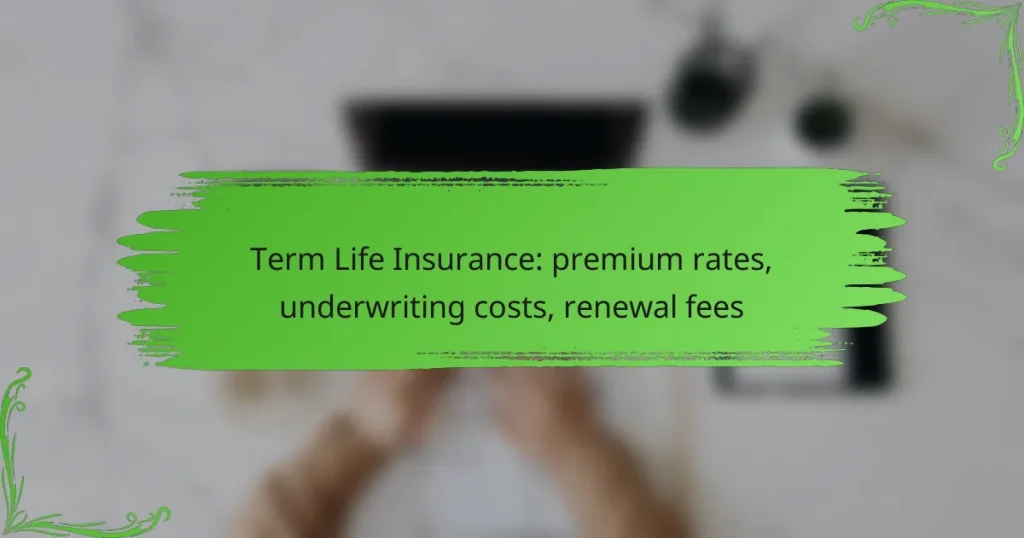Term life insurance offers a range of premium rates influenced by factors such as age, health, and the desired coverage amount, typically spanning from low tens to several hundred pounds monthly. Underwriting costs play a crucial role in determining these premiums, as they reflect the assessment of an applicant’s risk profile. Additionally, renewal fees may apply when extending coverage beyond the initial term, varying based on the insurer and the insured’s age and health at renewal time.

What are the premium rates for term life insurance in the UK?
Premium rates for term life insurance in the UK vary based on several factors, including age, health, and coverage amount. Generally, these premiums can range from low tens of pounds to several hundred pounds monthly, depending on individual circumstances.
Average monthly premiums
The average monthly premium for term life insurance in the UK typically falls between £10 and £30 for a healthy individual in their 30s seeking a coverage amount of around £100,000. As age increases, premiums can rise significantly, often doubling or tripling for older applicants.
For example, a 40-year-old might pay between £20 and £50 monthly, while a 50-year-old could see premiums ranging from £40 to £100. These estimates can vary widely based on personal health and lifestyle choices.
Factors affecting premium rates
Several key factors influence premium rates for term life insurance. Age is a primary determinant; younger individuals generally pay lower premiums. Health status, including pre-existing conditions and lifestyle habits such as smoking, also plays a crucial role in determining costs.
Coverage amount and term length are additional considerations. Higher coverage amounts and longer terms typically lead to increased premiums. Insurers may also assess occupation and hobbies, as higher-risk jobs or activities can elevate rates.
Comparison of top providers
When comparing top term life insurance providers in the UK, it’s essential to look at both premium rates and policy features. Major insurers like Aviva, Legal & General, and Aegon often offer competitive rates, but their coverage options and customer service can vary.
For instance, Aviva may provide lower premiums for younger applicants, while Legal & General might excel in customer satisfaction ratings. It’s advisable to obtain quotes from multiple providers and carefully review the terms to find the best fit for your needs.

How do underwriting costs impact term life insurance?
Underwriting costs significantly influence the overall premium rates of term life insurance policies. These costs arise from the assessment of an applicant’s risk profile, which determines how much the insurer will charge for coverage.
Definition of underwriting costs
Underwriting costs refer to the expenses incurred by insurance companies to evaluate the risk associated with insuring an individual. This process includes reviewing medical histories, lifestyle factors, and other relevant information to assess the likelihood of a claim being made.
These costs are essential for insurers to set appropriate premium rates that reflect the risk level of the insured. Higher underwriting costs may lead to increased premiums for policyholders.
Key factors in underwriting
Several key factors influence underwriting decisions, including age, health status, occupation, and lifestyle choices such as smoking or high-risk activities. For example, a younger, healthier applicant may face lower underwriting costs compared to an older individual with pre-existing health conditions.
Insurers may also consider family medical history and the applicant’s driving record. Each of these elements contributes to the overall assessment of risk and, consequently, the premium rates offered.
Impact on overall policy cost
The underwriting process directly affects the overall cost of a term life insurance policy. If an applicant is deemed high risk, the insurer may charge significantly higher premiums to cover potential claims.
On the other hand, individuals with favorable risk profiles can benefit from lower premiums. It’s advisable for applicants to maintain a healthy lifestyle and seek regular medical check-ups to potentially reduce underwriting costs and secure more affordable coverage.

What are the renewal fees for term life insurance policies?
Renewal fees for term life insurance policies are charges applied when a policyholder decides to extend their coverage beyond the initial term. These fees can vary significantly based on the insurer, the age of the insured, and the health status at the time of renewal.
Typical renewal fee structures
Renewal fee structures typically fall into two categories: level premiums and increasing premiums. Level premiums remain constant throughout the renewal period, while increasing premiums rise each year based on age or other risk factors. Some insurers may also offer a grace period for renewal, allowing policyholders to adjust their coverage without immediate fees.
For example, a policy with level premiums might charge a flat fee of around $300 annually, whereas a policy with increasing premiums could start at $250 and rise to $400 over time.
Comparison of renewal fees among providers
Renewal fees can differ widely among insurance providers. It’s essential to compare these fees when selecting a policy. Some companies may offer competitive rates for renewal, while others might have higher fees that increase significantly with age.
For instance, one insurer might charge $200 for renewal at age 40, while another could charge $350. A thorough comparison can help identify the best long-term financial commitment.
Factors influencing renewal fees
Several factors influence renewal fees for term life insurance. The most significant include the insured’s age at renewal, health status changes, and the length of the original term. As individuals age, their risk profile typically increases, leading to higher renewal costs.
Additionally, lifestyle changes, such as developing health conditions or engaging in riskier activities, can also impact fees. It’s advisable to maintain a healthy lifestyle and regularly review coverage options to mitigate potential increases in renewal fees.

How to choose the best term life insurance policy?
Choosing the best term life insurance policy involves evaluating your financial needs, understanding coverage options, and comparing different providers. Focus on the policy’s premium rates, underwriting costs, and renewal fees to ensure it aligns with your long-term financial goals.
Criteria for selection
When selecting a term life insurance policy, consider factors such as your age, health status, and the length of coverage you need. Premium rates can vary significantly based on these criteria, so it’s essential to assess your personal situation and budget.
Look for policies that offer flexible terms and options for conversion to permanent insurance if your needs change. Comparing multiple quotes can help you identify the best value for your specific requirements.
Importance of coverage amount
The coverage amount is crucial as it determines the financial protection your beneficiaries will receive. A common guideline is to aim for a coverage amount that is 10-15 times your annual income, but personal circumstances may require adjustments.
Consider any outstanding debts, future expenses such as education for children, and your family’s lifestyle needs when deciding on the coverage amount. Ensure that the policy provides adequate support for your loved ones in your absence.
Evaluating provider reputation
Assessing the reputation of the insurance provider is vital for ensuring reliability and customer satisfaction. Research customer reviews, industry ratings, and financial stability ratings from agencies like A.M. Best or Standard & Poor’s.
Choosing a well-established provider can give you peace of mind, knowing they have the resources to pay claims when needed. Additionally, consider their customer service track record, as responsive support can make a significant difference during the claims process.

What are the common misconceptions about term life insurance?
Many people hold misconceptions about term life insurance that can lead to confusion and poor decision-making. Understanding these myths is crucial for making informed choices regarding coverage, costs, and eligibility.
Misunderstanding coverage duration
A common misunderstanding is that term life insurance only provides coverage for a very short period. In reality, term policies can last anywhere from 10 to 30 years, allowing individuals to choose a duration that fits their financial planning needs.
When selecting a term, consider your financial obligations, such as mortgage payments or children’s education costs. A longer term may be more suitable if you have significant long-term liabilities.
Myths about affordability
Many believe that term life insurance is prohibitively expensive, but this is often not the case. Premiums can vary widely based on factors like age, health, and coverage amount, with many policies available for just a few dollars a month.
For example, a healthy 30-year-old might find term life insurance premiums in the low tens of USD per month for a substantial coverage amount. It’s advisable to compare quotes from multiple insurers to find the best rate.
Beliefs about health requirements
Some individuals think that only those in perfect health can qualify for term life insurance, which is a misconception. While health does impact premiums, many insurers offer policies that accommodate various health conditions.
It’s essential to be honest about your health status when applying, as undisclosed conditions can lead to denied claims later. Consider working with an insurance broker who can help navigate options that suit your health profile.

What emerging trends are shaping term life insurance in the UK?
Emerging trends in the UK term life insurance market are significantly influenced by advancements in technology and changing consumer preferences. These factors are reshaping how policies are underwritten, marketed, and sold, ultimately affecting premium rates and overall accessibility.
Impact of technology on underwriting
Technology is streamlining the underwriting process for term life insurance, making it faster and more efficient. Insurers are increasingly using data analytics and artificial intelligence to assess risk, which can lead to more accurate premium pricing and quicker approvals.
For example, some companies now offer instant quotes and decisions based on online questionnaires, reducing the traditional waiting period from weeks to just minutes. This shift not only enhances customer experience but also allows insurers to manage underwriting costs more effectively.
Shifts in consumer preferences
Consumer preferences are evolving, with a growing demand for flexibility and customization in term life insurance policies. Many individuals are seeking products that align with their specific life stages and financial goals, such as policies that allow for adjustments in coverage as their needs change.
Additionally, there is an increasing interest in digital platforms for purchasing insurance, as consumers prefer the convenience of managing their policies online. Insurers that adapt to these preferences by offering user-friendly digital experiences and tailored products are likely to gain a competitive edge in the market.


